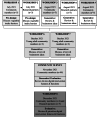Co-design of a personalised digital intervention to improve vegetable intake in adults living in Australian rural communities
- PMID: 38200514
- PMCID: PMC10782626
- DOI: 10.1186/s12889-024-17641-8
Co-design of a personalised digital intervention to improve vegetable intake in adults living in Australian rural communities
Abstract
Background: Diets low in vegetables are a main contributor to the health burden experienced by Australians living in rural communities. Given the ubiquity of smartphones and access to the Internet, digital interventions may offer an accessible delivery model for a dietary intervention in rural communities. However, no digital interventions to address low vegetable intake have been co-designed with adults living in rural areas. This paper describes the co-design of a digital intervention to improve vegetable intake with rural community members and research partners.
Methods: Active participants in the co-design process were adults ≥ 18 years living in three rural Australian communities (total n = 57) and research partners (n = 4) representing three local rural governments and one peak non-government health organisation. An iterative co-design process was undertaken to understand the needs (pre-design phase) and ideas (generative phase) of the target population. Eight online workshops and a community survey were conducted between July and December 2021. The MoSCoW prioritisation method was used to help participants identify the 'Must-have, Should-have, Could-have, and Won't-have or will not have right now' features and functions of the digital intervention. Workshops were transcribed and inductively analysed using NVivo. Convergent and divergent themes were identified between the workshops and community survey to identify how to implement the digital intervention in the community.
Results: Consensus was reached on a concept for a digital intervention that addressed individual and food environment barriers to vegetable intake, specific to rural communities. Implementation recommendations centred on (i) food literacy approaches to improve skills via access to vegetable-rich recipes and healthy eating resources, (ii) access to personalisation options and behaviour change support, and (iii) improving the community food environment by providing information on and access to local food initiatives.
Conclusions: Rural-dwelling adults expressed preferences for personalised intervention features that can enhance food literacy and engagement with community food environments. This research will inform the development of the prototyping (evaluation phase) and feasibility testing (post-design phase) of this intervention.
Keywords: Adults; Behaviour change; Co-design; Digital health; Intervention; Vegetable intake; Workshop.
© 2024. The Author(s).
Conflict of interest statement
The authors declare no competing interests.
Figures


Similar articles
-
Determining the feasibility of a codesigned and personalised intervention (Veg4Me) to improve vegetable intake in young adults living in rural Australian communities: protocol for a randomised controlled trial.BMJ Open. 2024 Jan 11;14(1):e078001. doi: 10.1136/bmjopen-2023-078001. BMJ Open. 2024. PMID: 38216197 Free PMC article.
-
Beyond the black stump: rapid reviews of health research issues affecting regional, rural and remote Australia.Med J Aust. 2020 Dec;213 Suppl 11:S3-S32.e1. doi: 10.5694/mja2.50881. Med J Aust. 2020. PMID: 33314144
-
Digital behaviour change interventions to increase vegetable intake in adults: a systematic review.Int J Behav Nutr Phys Act. 2023 Mar 27;20(1):36. doi: 10.1186/s12966-023-01439-9. Int J Behav Nutr Phys Act. 2023. PMID: 36973716 Free PMC article.
-
Identifying the barriers and facilitators to fruit and vegetable consumption in rural Australian adults: a mixed methods analysis.Nutr J. 2024 Jun 28;23(1):69. doi: 10.1186/s12937-024-00972-y. Nutr J. 2024. PMID: 38943157 Free PMC article.
-
Co-designing interventions to improve diets in rural communities.Proc Nutr Soc. 2025 Feb 6:1-7. doi: 10.1017/S0029665125000060. Online ahead of print. Proc Nutr Soc. 2025. PMID: 39910988 Review.
Cited by
-
Determining the feasibility of a codesigned and personalised intervention (Veg4Me) to improve vegetable intake in young adults living in rural Australian communities: protocol for a randomised controlled trial.BMJ Open. 2024 Jan 11;14(1):e078001. doi: 10.1136/bmjopen-2023-078001. BMJ Open. 2024. PMID: 38216197 Free PMC article.
-
Feasibility of a co-designed and personalised intervention to improve vegetable intake in rural-dwelling young adults.Int J Behav Nutr Phys Act. 2025 Jul 14;22(1):97. doi: 10.1186/s12966-025-01796-7. Int J Behav Nutr Phys Act. 2025. PMID: 40660295 Free PMC article.
-
Co-Designing a Digital Stroke Prevention Platform: Leveraging Lived Experience and Expert Advice.Health Expect. 2025 Jun;28(3):e70293. doi: 10.1111/hex.70293. Health Expect. 2025. PMID: 40405455 Free PMC article.
References
-
- Australian Institute of Health and Welfare, Rural and remote health. 2019.https://www.aihw.gov.au/reports/rural-remote-australians/rural-remote-he...
-
- Livingstone K, Olstad D, Leech R, Ball K, Meertens B, Potter J, Cleanthous X, Reynolds R, McNaughton S. Socioeconomic inequities in Diet Quality and Nutrient intakes among Australian adults: findings from a nationally Representative Cross-sectional Study. Nutrients. 2017;9(10):1092. doi: 10.3390/nu9101092. - DOI - PMC - PubMed
Publication types
MeSH terms
Supplementary concepts
Grants and funding
- MR/P020941/1/MRC_/Medical Research Council/United Kingdom
- APP1172987/National Health and Medical Research Council Emerging Leadership Investigator Grant
- ID106646/National Heart Foundation Future Leader Fellowship
- APP1173803/National Health and Medical Research Council Emerging Leadership Investigator Grant
LinkOut - more resources
Full Text Sources
Medical

